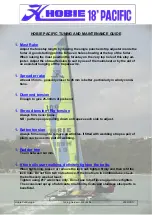
Seamax Inflatable Boat – English User Manual
- 4 -
2. ABOUT BOATING
The operator (driver) is responsible for the correct and safe operation of the boat and safety of its occupants and
general public. It is strongly recommended that each operator (driver) read and understand this entire manual before
operating the boat. Be sure at least one additional person on board is instructed in the basics of starting and operating
the outboard and boat handling in case the driver is unable to operate the boat. Remember in Canada you must have
a boating certification license for all motorized watercraft. All local rules and regulations apply to all waterways. If you
have any questions or concerns, please feel free to contact with us. Safety and operating information that is practiced,
along with using good common sense, can help prevent personal injury and product damage.
Boater’s operation license is required in Canada and USA when use the boat with an outboard engine or electric motor.
Your boat may have to be registered with Transport Canada or DMV office (Department of Motor Vehicles) before use.
Please make sure you and your boat can meet all the government requirements when you transport the boat on the
land or use the boat in the water.
LANYARD STOP SWITCH
The purpose of a lanyard stop switch is to shut down the engine in an emergency situation when the operator moves
from a safe operating distance (as in accidental ejection from the operator's position) to activate the switch. Tiller
handle outboards and some remote control units are equipped with a lanyard stop switch. A lanyard stop switch can
be installed as an accessory, generally on the dashboard or side adjacent to the operator's position. Should the
operator fall out of the boat, the possibility of serious injury or death from being run over by the boat can be greatly
reduced by stopping the engine immediately. Always properly connect both ends of the stop switch lanyard to the stop
switch and the operator.
The lanyard is coiled to make its at-rest condition as short as possible to minimize the likelihood of lanyard
entanglement with nearby objects. Its stretched-out length is made to minimize the likelihood of accidental activation
should the operator choose to move around in an area close to the normal operator's position.






































